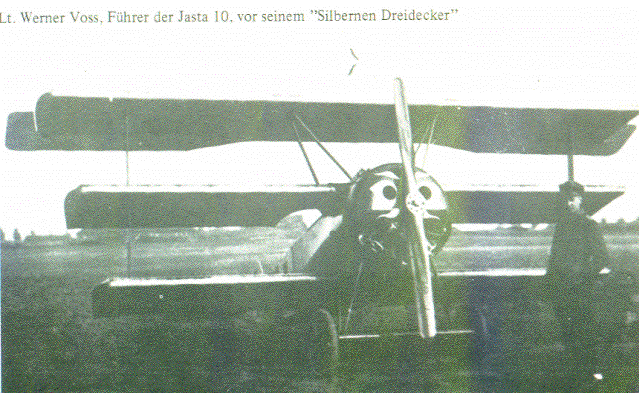Voß' Fokker Dreidecker
German Pilots were stunned when the Sopwith Triplane (affectionately called a "Tripe") first made its appearance on the Western Front. The nimble, agile, plane was finally a match for the Albatros. Although initially armed with only one Vickers MG, what it lacked in firepower was made up for by its outstanding maneuverability. German pilots demanded that a similar combat aircraft be produced for them. Anton Fokker was the man who would meet their demands.
 A side by side comparison of the two aircraft, shows that the Fokker DrI (Dreidecker or Triplane) was close to an exact copy of the Sopwith Tripe. In fact the outward appearance of the two planes was so similar that some British pilots were shot down when they mistook the new DrIs as Tripes. The Sopwith Tripes were grounded for a short time for fear that allied pilot might attack them by accident. It was eventually superceded by the Sopwith Camel and pulled from service. It was in active use for approximately seven months.
A side by side comparison of the two aircraft, shows that the Fokker DrI (Dreidecker or Triplane) was close to an exact copy of the Sopwith Tripe. In fact the outward appearance of the two planes was so similar that some British pilots were shot down when they mistook the new DrIs as Tripes. The Sopwith Tripes were grounded for a short time for fear that allied pilot might attack them by accident. It was eventually superceded by the Sopwith Camel and pulled from service. It was in active use for approximately seven months.
On July 21, 1917 Voß was chosen to test the new prototype Fokker Dreideckers, designated V4 Prototypes. He was extremely impressed with this plane and said it was the edge that would once again swing air supremacy back to the German side. The first two Fokker DrI prototypes were issued to issued to JG1 on 28 August 1917 and were given to Manfred von Richthofen (The Red Baron) and Werner Voß. The numbers for the two planes were F I 102/17 and F I 103/17. F I 101/17 was used for crash testing and was not issued to a pilot. F I 100/17 was the first prototype and was left at the factory.
Voß' plane was not a production DrI. It was a prototype V4. As such it was missing the wing skids and horizontal stabilizer, rudder, cowling, and ailerons all differed from production models. His palne also appears in many photographs as lighter in color than the production aircraft. Several other minor differences are noticable between the production DrI's and the V4 prototypes.
Also of note, the standard Oberusel engine was not installed in FI 103/17. Voß's aircraft had a captured LeRhône engine.
Popular accounts claim the Baron's was painted blood red. Others say Voß painted his silver blue streaked with olive. There is no clear evidence to support these allegations and most evidence suggest otherwise.
(See What Color Was Voß' Plane?)
Voß was chosen to test fly the first Fokker Dreideckers. He was immediately impressed with the handling characteristics and it was his report that convinced von Richthofen, who was on convalescent leave at the time, to accept the plane for Jagdgechwader One.
However, von Richthofen was unimpressed with the Triplane, at least at first, despite being the first pilot to claim a victory with it. (He attributed his success on the British observer mistaking his Dreidecker for a Sopwith Triplane) Its major drawback was that it was slower than his Albatros D V. It is common knowledge that von Richthofen was just a fair pilot. His remarkable success is often attributed to his cunning, bravery, and hunting instinct. The DrI was not necessarily designed with the Baron's particular flying skills in mind. Von Richthofen disliked the plane so much that he initially went back to his Albatros and gave (or shared) his first DrI to another pilot, Lt. Kurt Wolff.
Voß, on the other hand was extremely impressed with the Triplane. It was almost as if the Triplane was made for someone like Voß. The plane was nimble and quick. It climbed extremely fast and could twist and turn better than any other fighter that had yet been produced. Voß quickly started to rack up victory after victory. Voß' extraordinary flying abilities complemented the DrI and he declared that with this plane he would quickly become the number one ace in all of Germany. It was at this time that von Richthofen took notice and gave the triplane a second chance.
Of Dreidecker Pilots, Voß' score ranked third, though he only flew the plane for about a month (28 August 1917 - 23 September 1917).
See also Kaiser Willy, LeRhône engine, and What Color was Voß's Plane

 A side by side comparison of the two aircraft, shows that the Fokker DrI (Dreidecker or Triplane) was close to an exact copy of the Sopwith Tripe. In fact the outward appearance of the two planes was so similar that some British pilots were shot down when they mistook the new DrIs as Tripes. The Sopwith Tripes were grounded for a short time for fear that allied pilot might attack them by accident. It was eventually superceded by the Sopwith Camel and pulled from service. It was in active use for approximately seven months.
A side by side comparison of the two aircraft, shows that the Fokker DrI (Dreidecker or Triplane) was close to an exact copy of the Sopwith Tripe. In fact the outward appearance of the two planes was so similar that some British pilots were shot down when they mistook the new DrIs as Tripes. The Sopwith Tripes were grounded for a short time for fear that allied pilot might attack them by accident. It was eventually superceded by the Sopwith Camel and pulled from service. It was in active use for approximately seven months.